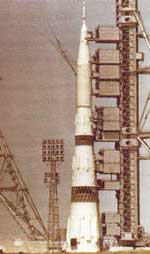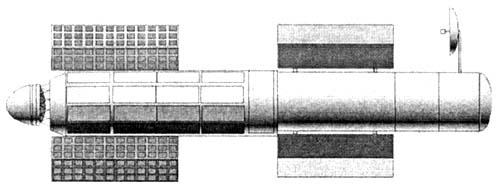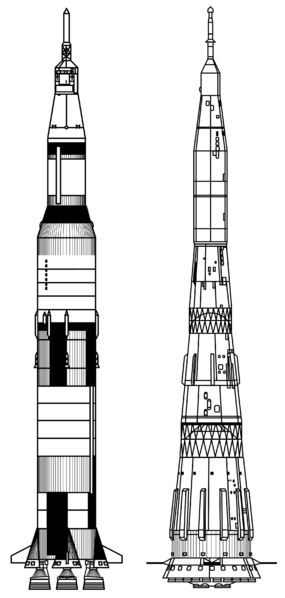H-1, apotheosis and sixties epic fail
Dedicated to a recent family trip to the space museum
What is this post about?
I’ll try to tell in an accessible form about the most amazing and, probably, the most tragic episode of the Soviet cosmonautics - the history of the development of the N-1 superheavy class rocket.

How it all began
The official start of the N-1 project was laid by the Decree of the Government of the USSR on June 23, 1960 "On the creation of powerful launch vehicles, satellites, spacecraft and space exploration in 1960-1967." The Decree provided for "holding in 1960-1962. design and development work and the necessary amount of research in order to create a new space rocket system with a launch mass of 1000-2000 tons in the coming years, which will ensure the launch of a heavy interplanetary spacecraft weighing 60-80 tons into the orbit around the Earth, powerful liquid-propellant rocket engines with high characteristics, "Liquid-hydrogen rocket engines, nuclear and electric engines, high-precision autonomous and radio-technical control systems, space radio communication systems, etc."
In fact, the Decree consolidated the preliminary design of the Queen of the launch vehicle, already in progress at OKB-1, intended for a wide range of tasks - the launch of heavy geostationary satellites, a large orbital station, and, finally, the launch of TMK - a heavy interplanetary ship.
For design studies, an option was adopted with a payload mass of 75 tons in low Earth orbit. Calculations showed that such a mass would be optimal for assembling large stations and interplanetary spacecraft in orbit. Starting payload weight of 2200 t corresponds to this payload mass, and it was taken into account that the use of hydrogen as fuel in the upper steps instead of the originally planned kerosene will increase the payload mass to 90-100 t with the same starting weight.
TMK
The N1-TMK complex is the most striking project of the Korolev, the apogee of his activity as the Chief Designer. Despite the loss (and destruction) of archival materials, some information about this project, for which the N-1 rocket was originally intended, has been preserved.
The original version, the TMK-1 ship, was intended for a manned flight to Mars of a crew of 2-3 people along the flight path (without landing) with subsequent return to the ground.
TMK-1 had the following dimensions: full length - 12 meters, maximum diameter - 6 meters. The total mass of the ship was 75 tons, which made it possible to launch it in 1 launch of the N-1 rocket.
 TMK-1 included residential, working, biological, aggregate compartments, a descent vehicle for returning to Earth and a corrective propulsion system. After launching on the flight path, the ship deployed solar concentrators and power batteries, as well as communication antennas with the Earth, and began a months-long non-stop flight.
TMK-1 included residential, working, biological, aggregate compartments, a descent vehicle for returning to Earth and a corrective propulsion system. After launching on the flight path, the ship deployed solar concentrators and power batteries, as well as communication antennas with the Earth, and began a months-long non-stop flight. To cope with the problem of weightlessness, a variant of artificial gravity was created, created by the rotation of individual ship blocks around an axis. This technique was relatively simple, but it led to a new problem - the small size of the “centrifuge” led to the appearance of Coriolis accelerations, distorting a person’s perception of gravity and adversely affecting the body. Then they decided to abandon the constant rotation and briefly turn on the rotation of the blocks only in certain areas of the flight.
To work out the elements and blocks of a closed LSS on Earth, as well as to clarify the psychological issues of a crew staying in a closed spacecraft, an analogue of TMK's living compartment was built - a ground-based experimental complex in which testers G. Manovtsev, V. Ulybyshev and A. Bozhko spent a year .
 Further development of the TMK project was the IEC - Martian Expeditionary Complex. The project received the unofficial name of “Aelita”.
Further development of the TMK project was the IEC - Martian Expeditionary Complex. The project received the unofficial name of “Aelita”.The ship consisted of two unmanned units weighing 75 tons, which were put into orbit by N-1M rockets. The first block, in turn, consisted of two sections - the IOC (Martian Orbital Complex) and the IPC (Martian Landing Complex). The second block was a complex electric propulsion system (ERE) with a nuclear energy source.
The full length of the IEC was 175 meters, the maximum diameter was 4.1 meters, and the total mass was 150 tons.
According to the plan, after the docking of the MEK / IPK and YaEDU blocks, the ship was withdrawn from the zone of the Earth's radiation belts. Then the crew was delivered to the complex, using the "Probe" ships. The acceleration of the complex was carried out in a gradually unwinding spiral. The duration of the flight to Mars and back was 630 days.
It was assumed that after the end of the active phase of acceleration, the nuclear power plant shuts down, the power plant goes into idle mode and the complex makes a passive flight for 150 days. Then begins the second active segment of the flight to Mars - deceleration (61 days), flight in a twisting spiral to enter the ISM orbit (24 days), as a result of which the IEC is in a near-Martian orbit. During a 30-day stay in orbit of the ISM, the IPC is separated from the complex, which will make a soft landing on the surface of Mars and will be there for 5 days. Having completed the research, the take-off part of the IPC starts from Mars, which goes beyond the orbit of the artificial satellite of Mars, carries out mutual search, rendezvous and docking with the IOC. The astronauts move into the living compartments of the orbital complex,
After this comes the third part of the flight - return to Earth. The IOC engines are switched on for acceleration, which lasts 17 days in the field of action of Mars and another 66 days outside of its limits. After a long passive phase, when the trajectory of the complex passes as close as possible to the Sun (between Venus and Mercury), a 17-day active return phase follows - in fact, this was done to correct the trajectory to reduce the duration of the flight by increasing speed. Next, there is the passive section again, and three days before the flight to Earth, the nuclear power engine switches on again, reducing the speed of the complex. At the final site, at the entrance to the Earth's sphere of action, the descent vehicle is separated from the IEC and makes a soft landing.
Metamorphoses
In 1961, US President Kennedy set the national task of becoming the first on the moon .
The Soviet space program at that time did not provide for a landing on the moon. The plans included the improvement of the manned spacecraft Sever and Soyuz, the construction of an orbital station and the preparation of the TMK project. However, the political resonance from Kennedy’s statement was so great that at the very top a decision was made to “catch up and overtake”.
Since the lunar program first of all needs an appropriate carrier, it is logical that the “N-1” being in a sufficient degree of readiness was reoriented specifically for flights to the moon.
To this end, the development of the forced N-1F variant was launched, capable of bringing 90 tons of cargo into low Earth orbit, which was the minimum value for a manned crew flight of two people with one of them landing on the lunar surface in one launch and the L3 manned complex .
Unfortunately, the goal was not achieved. There are several reasons for this, carefully analyzed by experts in due time:
- Excessive boosting missiles. A dimension of 75 tons was enough for the initial tasks, but it was not enough for a flight to the moon. The increase in carrying capacity of up to 90 tons, carried out in a hurry, led to insufficient elaboration of the design.
- Initially the wrong choice of engine dimension for the rocket. Instead of equipping the first stage with 30 (thirty!) Low-power engines, it was necessary to spend time and resources on designing engines of higher power. However, the personal conflict between the two designers - Korolev and Glushko did not allow this to be done.
- Refusal from the gradual development of nodes and blocks of the rocket at the stand. In order to save time, it was decided to debug the rocket by test launches. None of them completed successfully.
In addition to the lunar program for N-1, another application was prepared - as a global nuclear ballistic missile.
The Raskat program included equipping the N-1 with seventeen warheads with individual guidance on the target. One launch of Raskat guaranteed to cover the entire territory of a potential enemy ...
Unfortunately, no details about the Raskat program were preserved.
Flight tests
 The first launch of the N1 carrier with the Zond-M unmanned vehicle as a payload on February 21, 1969, ended abnormally. As a result of a fire in the tail section (engine No. 2) and a malfunction in the engine control system, this system issued a false command for 68.7 seconds to turn off all engines, followed by a carrier explosion at an altitude of 12.2 km.
The first launch of the N1 carrier with the Zond-M unmanned vehicle as a payload on February 21, 1969, ended abnormally. As a result of a fire in the tail section (engine No. 2) and a malfunction in the engine control system, this system issued a false command for 68.7 seconds to turn off all engines, followed by a carrier explosion at an altitude of 12.2 km.The second launch of H1 with the Zond-M unmanned vehicle and a prototype of the lunar landing ship of the L3 complex was carried out on July 3, 1969 and also ended abnormally due to the abnormal operation of engine No. 8 of block A and all engines being turned off for 23 flights, after which the carrier fell to the start place. As a result of the largest explosion in the history of rocket science, one launch pad was completely destroyed, and the second was seriously damaged. It took two years to analyze the test results, additional calculations, research and experimental work, and restore the launching tables.
The third launch of the N1 carrier with the model of the unmanned lunar orbital ship and the model of the lunar landing ship of the L3 complex was carried out on June 27, 1971. All 30 engines of Block A reached the preliminary and main thrust stages and functioned normally, however, as a result of an off-balance turning moment when maneuvering away from the launch pad, the rocket gained a roll and continued uncontrolled flight, which did not provide for launching into orbit. Since, for the sake of guaranteeing the safety of the launch complex, the emergency engine shutdown command was blocked for up to 50 s, their shutdown by the monitoring system and the blasting of the carrier that had lost its head and began to collapse were made at 51 s and an altitude of 1 km.
It is interesting to note the fact that the emergency rescue system worked normally, the lunar landing ship was withdrawn from the falling rocket and made a safe landing a few kilometers from the start.
On November 23, 1972, the last fourth launch of H1 was made with an unmanned lunar orbital ship and a model of the lunar landing ship of the L3 complex. Flight control was carried out for the first time by an onboard computer based on gyro platform commands (chief designer N. A. Pilyugin). The composition of the propulsion systems introduced steering engines, fire extinguishing system.
The missile flew 106.93 s without comment to an altitude of 40 km, but 7 seconds before the estimated time of separation of the first and second stages, an almost instantaneous destruction of the oxidizer pump of engine No. 4 occurred, which led to the liquidation of the rocket.
End of project
So, the flight tests of the "N-1" ended in failure, in fact. Despite the fact that two more missiles were in different stages of readiness, a decision was made to terminate the N-1 program. The main motive was that the Soviet Union actually lost the lunar race - and the manned flyby of the moon and landing on the surface were by then successfully carried out by American astronauts. The leadership did not see other uses for the N-1, the TMK project was postponed, and the military demanded the development of a program of long-term orbital stations (Almaz and TKS projects), for which a rocket of this dimension was not needed.
In June 1974, all work on the N1-LZ complex was discontinued. The existing backlog was destroyed, the costs were written off (in the prices of the 70s, the costs amounted to about 4 billion rubles).
Comparison with analogues
The only analogue of the N-1 was at that time the American "moon" rocket Saturn-V Werner von Braun.

| parameter | Saturn-v | N-1 |
|---|---|---|
| number of steps | 3 | 3 |
| Earth orbit payload | 140 t | 90 t (100 t in forced version) |
| near-moon orbit payload | 41 t | 31 t (34 t forced) |
| fuel | kerosene and liquid oxygen in the first stage, liquid hydrogen and liquid oxygen in the second and third | kerosene and liquid oxygen |
| engines | first stage: 5 pcs. F-1 second stage: 5 pcs. J-2 third stage: 1 pc. J-2 total: 11 pcs. | first stage: 30 pcs. NK-15 (NK-33) second stage: 8 pcs. NK-15V (NK-43) third stage: 4 pcs. NK-31 (NK-21) total: 42 pcs. |
Carrying out a direct comparison of N-1 with Saturn-V now, from the height of decades, of course, it is easy to notice the general backwardness of the "royal" project. However, do not forget about the conditions in which these missiles were created. The lunar program in the United States had the status of a national project; NASA was created to coordinate all work on the rocket, ship, astronaut training, etc. and having almost unlimited funding. Korolev was forced to work “on the table”; in fact, the N-1 was useless to anyone. An attempt to catch up with America in the lunar race by speeding up the development of N-1 led, ultimately, to the collapse of both the Soviet lunar program and the rocket, which was not originally intended for the tasks that had fallen on it.
References to sources
www.buran.ru/htm/gud%2019.htm
en.wikipedia.org/wiki/%D0%9D-1
en.wikipedia.org/wiki/%D0%A1%D0%B0%D1%82%D1% 83% D1% 80% D0% BD_V
tvroscosmos.ru/?page=zarraketa
www.skeptik.net/conspir/mishin.htm
www.skeptik.net/conspir/append4.htm
physicsbooks.narod.ru/Apollo/N1/N1 .HTM
polnaya-chush.blogspot.com/2009/02/34.html
astrotek.ru/proekt-aelita
astrotek.ru/tmk-tyazhelyj-mezhplaetnyj-korabl-kfeoktistova
PS I can not find a thematic blog for this entry ...
